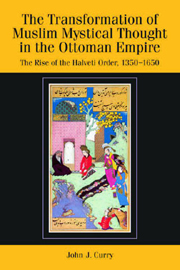 The Transformation of Muslim Mystical Thought in the Ottoman Empire
The Transformation of Muslim Mystical Thought in the Ottoman Empire from PART II - THE EVOLUTION OF A HALVETİ SUB-BRANCH: THE LIFE AND CAREER OF ŞAcBÂN-I VELİ AND HIS FOLLOWERS IN THE KASTAMONU REGION
Published online by Cambridge University Press: 12 September 2012
On the southwest side of the modern town of Kastamonu in the Black Sea region, behind the hilltop fortifications that once guarded this strategic route through northern Anatolia, lies the tomb and mosque of the great Halveti saint S¸acbân-ı Veli Efendi (d. 976/1569). It remains an important spiritual and historical landmark in the city of Kastamonu to the present, and is still visited regularly by the local community (see Figure 2). While tracing his spiritual ancestry back to Yahyâ-yı S¸irvânî, like most of the other Halveti shaykhs, S¸acbân is best known for founding the major branch of the Halveti order known as the S¸acbâniye, whose silsile can be seen in Appendix II. While this branch of the order became a powerful political and social force in Ottoman circles in the second half of the seventeenth century under the guidance of key figures such as Karabâs¸ cAlî Veli (d. 1096/1685) and Nasûhî Efendi (d. 1130/1718), its earlier history and development have still not received the comprehensive study that they deserve.
Our sources on Şacbân-ı Veli's life and history derive almost entirely from the work of cÖmer el-Fuɔâdî (d. 1044/1636), who is the subject of Part III of this work. A complex interaction between author and subject informs Fuɔâdî's writing about Şacbân-ı Veli, so a certain degree of foreshadowing of some of the circumstances surrounding the composition of the hagiography and a brief explanation of its character are in order before proceeding to the events that it describes.
To save this book to your Kindle, first ensure [email protected] is added to your Approved Personal Document E-mail List under your Personal Document Settings on the Manage Your Content and Devices page of your Amazon account. Then enter the ‘name’ part of your Kindle email address below. Find out more about saving to your Kindle.
Note you can select to save to either the @free.kindle.com or @kindle.com variations. ‘@free.kindle.com’ emails are free but can only be saved to your device when it is connected to wi-fi. ‘@kindle.com’ emails can be delivered even when you are not connected to wi-fi, but note that service fees apply.
Find out more about the Kindle Personal Document Service.
To save content items to your account, please confirm that you agree to abide by our usage policies. If this is the first time you use this feature, you will be asked to authorise Cambridge Core to connect with your account. Find out more about saving content to Dropbox.
To save content items to your account, please confirm that you agree to abide by our usage policies. If this is the first time you use this feature, you will be asked to authorise Cambridge Core to connect with your account. Find out more about saving content to Google Drive.